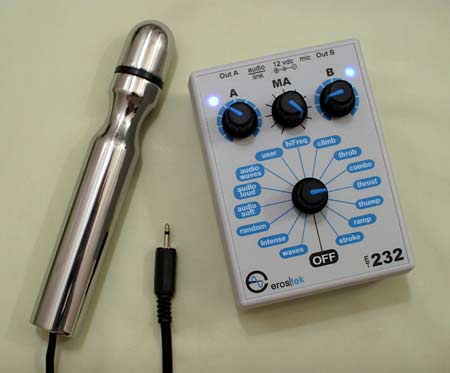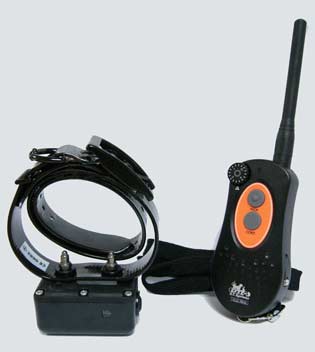
Photo by Interiot (license: CC BY-SA 3.0)

Photo by Interiot (license: CC BY-SA 3.0)
Electrostimulation can be painful or erotic (or both since pleasure from pain should not really be news to anyone familiar with BDSM). There are numerous resources available detailing electrical play in BDSM, and my intention here is not to go into depth regarding all of the particulars, but rather to throw around some ideas for how electrostimulation can be incorporated into ponyplay.
My focus will be on the application of electrostimulation to the training of the human pony. This typically entails short bursts of electrical stimulation, or "shocks", rather than the continuous stimulation that might be employed in other BDSM play scenes. These shocks are typically designed to be painful (i.e. negative reinforcement), but they can also be used for positive reinforcement by adjusting the voltage and/or frequency to make them pleasurable.
What determines if a shock is pleasurable or painful? Well a few factors come into play here:
From the list above, it is apparent that we require two separate items to engage in electrical play: a power supply and electrodes. Regarding power supplies, there are a few commercial units available and most commercial e-stim power supplies (e.g. the Electro-Stimulation P.E.S. Power Box or the Eros Tek ET232) will give you the (limited) ability to change numbers 1 or 3 (voltage and frequency). Power supplies are not particularly cheap, but I would highly discourage the use of homemade units.

Photo by Лана Шпак (license: CC BY-SA 3.0)
If you cannot afford an e-stim power supply, a shock collar (marketed as dog training aids) is a possibility, but these tend to have even more limited options, typically only a few different voltage ("intensity") settings and no frequency adjustment. Moreover, if you do not wish to apply the shock to the neck of your ponyboy (or ponygirl), you will either have to be creative in attaching the collar to other body parts, or you will need to remove the prongs of the collar and attach wires leading to separate electrodes which you can then place on your pony.
Both of those limitations are not really that bad, but just be aware of them, and keep in mind that nearly every setting on a shock collar will be painful (i.e. there is no real option for positive reinforcement here, but some might view that as an advantage anyway). Also, it should be noted that even low end shock collars are not cheap. My take is that a shock collar is another cool toy to have around, but it is not a replacement for an e-stim power supply, but that's just my opinion.
Number 2 is where you have the greatest flexibility. Commercially available e-stim electrodes are available in many form factors such as a rod or dildo shape for insertion (into the butt, vagina, or urethra), patches (can be applied to the breasts, or a male pony's balls), sheaths (around the cock), etc. And homemade electrodes offer even more flexibility.
Whether you are using a shock collar or an e-stim power supply with electrodes, shocks are administered by the pony's trainer, who is the one holding the power supply or remote control, and who chose where the electrodes should be positioned on the pony's body (try to make sure that they are positioned so that repeated shocks will not cause burning of the pony's skin). The ponyboy's trainer will administer shocks based on whatever criteria she chooses, and she will determine the intensity of the shocks, and thus whether they are painful or pleasurable, punishment or reward.
Shocks will usually be administered to a pony at the end of a lunge line or perhaps running free in an arena or fenced pasture where direct application of a crop would be difficult. In this way, the shock takes the place of a crop aid. However, while shocks can be used in place of conventional aids, such as the crop, we are missing out on the greatest utility of electric shocks as training aids: automating low supervision training tasks.
So what exactly is a "low supervision training task" and how can they automated with e-stim? Well, such tasks are usually those that merely require the compliance of the pony in performing a repetitive task or to refrain from a certain type of behavior. As such they include:

Figure by cPony
Those are the most common types of training tasks that can be easily automated, and indeed, in many cases, these tasks are better and more easily performed by an automated system that can deliver adverse stimuli as soon as the pony is out of compliance. Moreover any of the above can be combined (e.g. requiring a pony to walk or trot within a small area, remain four legged while doing so and have to whinny every 5 minutes).
The photo on the right shows a bio-horse whinny (A) compared to a poor imitation by a ponyboy (B). Note that the ponyboy's attempt at a whinny is still confined to frequencies much higher than ordinary human speech, but still lacks the structure of a true whinny (the ponyboy's whinny consists of a relatively narrow band of high frequency sound along with the associated harmonics). The collar worn by the ponyboy in this instance did not deliver a shock because it was programmed to allow any sound so long as its frequency components were sufficiently above normal human speech (85-180 Hz for males and 165-255 Hz for females). This is sufficient in most instances, but still it would be nice to require the ponyboy to have a more structured whinny similar to that of a bio-equine.
To develop a system like this is actually not so difficult in principle, but the practicalities of integrating a remote controlled shock system with an appropriate sensor may require some programming skills. Since this is an introductory article, I will not go over the details here (a system like the above is something I have in development, and I will post more details separately when I get a good working prototype).
If you're interested, I have separate articles on electrified butt plugs, urethral rods, and electric shock collars.